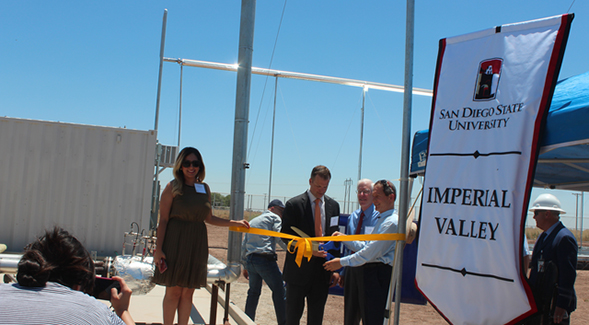Solar Research Shimmers in Imperial Valley
Three partnership projects under development at the Brawley campus are advancing clean energy for California.

The projects include research that could benefit development of fuel cell vehicles, and improvements in steam production for industrial purposes.
The June 27 event in Brawley was co-hosted by SEC and Southern California Gas Co. in collaboration with Hyperlight Energy, Genifuel Corporation, STARS Technology Corporation, Pacific Northwest National Laboratory and the National Renewable Energy Laboratory (NREL). The event also included tours of the three projects operating on a 1.5-acre plot at SEC.
“What we do is foster cutting-edge renewable energy research, and provide academic and professional education relevant to California’s energy future,” SEC coordinator Araceli Saucedo said. “SEC has educational and research facilities with ample room for project testing from its initial stages through its demonstration. We also offer a location for development of solar, wind and biofuel resources."
Saucedo added that the center is working to add science laboratory space for students and research through synergistic public private partnerships.
“We know that there is no simple, single solution to the problem of climate change,” said Yuri Freedman, senior director of business development for SoCalGas. “That is why these types of partnerships, and the research that develops from them, are critical for reaching our environmental goals and keeping California at the forefront of clean energy leadership.”
Steam from the sun
Among the projects featured is San Diego-based Hyperlight Energy’s concentrated solar power technology that uses the sun to produce steam for industrial purposes. The installation features an elevated solar reflector to intensify the energy and heat transfer to water flowing through plastic tubes to produce high-temperature steam.
Hyperlight recently received a $6.5 million California Energy Commission (CEC) grant to move to commercialization. Co-founder and CEO John King said, “California is achieving 33 percent energy efficiency. But that was the low-hanging fruit. We can’t take energy research for granted now.”
At SEC, Hyperlight’s steam is used with Genifuel’s hydrothermal processing technology that uses heat and pressure to convert wet waste material, such as manure, sludge or waste material, into renewable energy and gas.
Powered by manure
Genifuel Corp. President James Oyler said using solar heated processing fluid reduces greenhouse gas emissions more than traditional anaerobic digestion, and costs about half as much. The Genifuel project at SEC uses manure from rural dairies in Imperial and San Diego counties.
Oyler said, “There are enormous amounts of materials which would otherwise degrade the environment instead of contributing clean, renewable energy.”
The third technology demonstrated was STARS Technology Corporation’s solar thermochemical advanced reactor system (STARS) that produces hydrogen from solar energy much more efficiently than current methods.
Hydrogen fuel cell car development has lagged because of costs, noted Robert Wegeng, president of STARS Technology Corporation. “Combining concentrated solar energy with advanced chemical process units gives fuel cell vehicles an opportunity to compete,” he said, “and will help California achieve its goals of net-neutral carbon emissions by 2045.”
The three projects have all received funding from SoCalGas, the California Energy Commission, and the U.S. Department of Energy to support the commercialization of low-cost, commercial-scale renewable energy technology.



